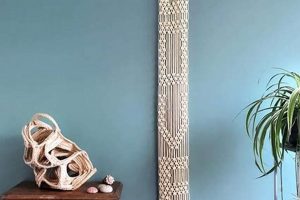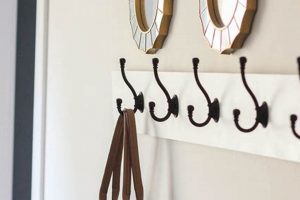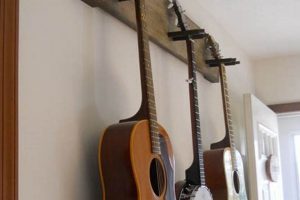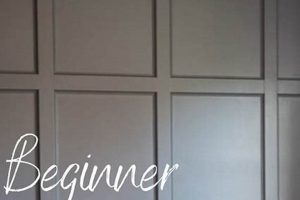The procedure of adding thermal resistance to existing wall cavities from the interior, circumventing the need to dismantle and later replace the existing wallboard, constitutes a specific form of home improvement. This method typically involves introducing insulation material through pre-existing or newly created access points. For instance, if a dwelling has hollow wall cavities, insulation can be blown in through a small hole, improving energy efficiency without extensive demolition.
Undertaking this type of project offers several advantages, including reduced disruption to the living space, lower initial material costs compared to full wall renovation, and a potentially faster completion time. Historically, homeowners have sought methods to improve energy efficiency as a means to reduce utility bills and enhance comfort. As energy costs rise and environmental awareness increases, strategies that minimize construction waste and labor expenses become even more appealing.
Effective implementation requires careful planning, the appropriate selection of insulation material, and the use of specialized tools. The following sections will delve into the materials, techniques, and considerations for successfully improving wall insulation without the complexities of drywall removal.
Enhancing Wall Insulation Without Drywall Removal
Improving the thermal performance of walls without removing the existing drywall requires meticulous planning and execution. The following tips outline essential steps to ensure the success of the project.
Tip 1: Conduct a Thorough Assessment: Before commencing any work, evaluate the existing wall cavities. Identify any obstructions, such as firebreaks or wiring, which may impede insulation placement. Utilize a borescope or similar inspection tool to gain visual access to the cavity interior.
Tip 2: Select Appropriate Insulation: Choosing the correct insulation material is crucial. Options include loose-fill cellulose, fiberglass, or spray foam. Consider factors such as R-value, moisture resistance, and ease of installation within enclosed cavities. Dense-packed cellulose is often favored for its ability to fill gaps effectively.
Tip 3: Utilize Proper Installation Techniques: Drilling access holes requires precision. Use a hole saw of appropriate diameter (typically 2-3 inches) and drill between studs, preferably near the top of the wall. For blown-in insulation, ensure adequate pressure and coverage to achieve optimal density and R-value.
Tip 4: Seal Air Leaks Meticulously: Air infiltration diminishes the effectiveness of insulation. Prior to insulation, seal any visible gaps or cracks around windows, doors, and baseboards. After insulating, carefully patch and seal the access holes to prevent air leakage.
Tip 5: Address Moisture Concerns: Introduce moisture barriers if necessary. Especially in humid climates, ensure adequate ventilation to prevent moisture buildup within the wall cavities, which can lead to mold growth and reduced insulation effectiveness.
Tip 6: Prioritize Safety Measures: When working with insulation materials, wear appropriate personal protective equipment (PPE), including a dust mask, eye protection, and gloves. Ensure adequate ventilation during installation and cleanup.
Tip 7: Research Local Building Codes: Before starting, familiarize yourself with local building codes and regulations regarding insulation installation. Compliance is essential for safety and potential resale value of the property.
By following these tips, it is possible to substantially improve the thermal performance of existing walls, leading to energy savings and increased comfort, without the extensive labor and expense associated with drywall removal.
Careful planning and execution are paramount for a successful outcome. Addressing potential issues and adhering to safety guidelines will contribute to an effective and durable insulation solution.
1. Assessment
The initial phase of any wall insulation project completed without drywall removal is a comprehensive assessment. This evaluation determines the feasibility, required materials, and potential challenges of the undertaking. A thorough assessment directly impacts the efficacy and longevity of the insulation upgrade. Failure to conduct a proper assessment can result in ineffective insulation, moisture problems, or structural damage. For example, if an assessment fails to identify existing mold or water damage within the wall cavity, adding insulation will exacerbate the problem, creating a breeding ground for further fungal growth and potentially compromising the building’s structural integrity. Similarly, neglecting to identify firebreaks or other obstructions within the wall cavity will hinder the proper and uniform distribution of insulation, reducing its overall effectiveness.
Detailed assessments should encompass several key areas. First, the existing wall construction must be determined stud spacing, cavity depth, and the presence of existing insulation. Second, the potential for air leakage should be evaluated, identifying gaps around windows, doors, and electrical outlets. Thermal imaging can be a valuable tool for this purpose. Third, the presence of any existing insulation should be identified, including its type, condition, and R-value. This information will influence the choice of new insulation material and installation method. For instance, if existing insulation is fiberglass batts that have settled or become compressed, loose-fill insulation can be added to fill gaps and increase the overall R-value. Fourth, moisture levels within the wall cavity should be checked using a moisture meter to detect any existing leaks or condensation problems. Finally, the assessment should take into account local climate conditions and building codes, ensuring that the selected insulation material and installation method comply with relevant regulations.
In summary, the assessment stage forms the foundation of any successful insulation project completed without removing drywall. A meticulous assessment identifies potential problems, informs material selection, and ensures that the insulation is installed effectively and safely. Overlooking this crucial step can lead to costly mistakes, reduced energy savings, and potential health hazards. Therefore, a thorough and accurate assessment is paramount for achieving the desired results.
2. Material Selection
Appropriate material selection constitutes a cornerstone of effective wall insulation when the existing drywall remains in place. This choice dictates the insulation’s performance, longevity, and overall impact on the dwelling’s energy efficiency. Improper material selection can lead to diminished thermal resistance, moisture accumulation, and potential structural issues, negating the benefits of the insulation effort.
- R-Value and Thermal Resistance
R-value, a measure of thermal resistance, directly affects the insulation’s ability to impede heat transfer. For existing wall cavities, materials with high R-values per inch, such as spray foam or dense-packed cellulose, are advantageous. These materials maximize thermal performance within the limited space. Inadequate R-value selection will result in insufficient insulation, negating energy-saving potential.
- Moisture Permeability
The ability of insulation to allow moisture to pass through it is critical in existing wall assemblies. Materials with high moisture permeability, such as cellulose, can help prevent moisture accumulation within the wall cavity. Closed-cell spray foam, with low permeability, may trap moisture, potentially leading to mold growth and structural damage if not properly managed with vapor barriers and ventilation strategies. This facet must align with the climate and existing wall construction.
- Installation Method Compatibility
The insulation material must be compatible with the chosen installation technique. Blown-in materials, such as cellulose or fiberglass, are suitable for filling enclosed cavities. Injection foam requires specialized equipment and expertise. Using an incompatible material can lead to uneven distribution, reduced R-value, and potential damage to the existing wall structure.
- Material Density and Settling
Density influences the insulation’s resistance to settling over time. Denser materials, such as dense-packed cellulose, resist settling, maintaining consistent R-value throughout the wall cavity. Lower-density materials, like loose-fill fiberglass, may settle, creating voids and reducing overall thermal performance. Addressing settling potential is crucial for long-term insulation effectiveness.
The interconnectedness of these facets highlights the critical role of material selection in achieving optimal wall insulation without removing the drywall. Carefully evaluating these characteristics ensures that the chosen material effectively enhances thermal performance, manages moisture, and maintains its integrity over time. Informed material selection is essential for maximizing energy savings and preventing potential problems within the existing wall assembly.
3. Access Creation
Access creation forms an indispensable element in projects designed to insulate existing walls without removing the drywall. This step entails the strategic placement of entry points through which insulation material can be introduced into the wall cavity. The method and location of these access points directly influence the thoroughness of insulation coverage and the overall effectiveness of the insulation upgrade. Improper access creation can result in incomplete insulation, leaving voids within the wall cavity and compromising the thermal performance of the building envelope. For instance, if access holes are too small or spaced too far apart, insulation may not reach all areas of the wall, creating cold spots and potential condensation issues. Conversely, excessively large or numerous holes can weaken the wall structure and increase the risk of air leakage.
The process typically involves drilling holes, often 2-3 inches in diameter, between the wall studs. The optimal placement depends on several factors, including stud spacing, wall height, and the type of insulation being installed. For blown-in insulation, access holes are commonly located near the top of the wall cavity to allow gravity to assist in the distribution of the material. In multi-story dwellings, access may be required on each floor to ensure complete coverage. The precision of access creation extends to minimizing damage to existing wiring or plumbing within the wall. The use of stud finders and, in some cases, borescopes, is recommended to avoid unintended punctures or structural compromises. Following insulation installation, these access points require meticulous sealing and patching to restore the integrity of the wall and prevent air infiltration.
In summary, access creation is a critical determinant of success when insulating walls without drywall removal. The strategic and precise establishment of entry points enables the effective introduction of insulation material, contributing to enhanced thermal performance and energy efficiency. Careful planning, execution, and subsequent sealing of access points are essential to avoid compromising the structural integrity of the wall and ensure the long-term benefits of the insulation upgrade.
4. Insulation Method
The selection and application of a specific insulation method are central to effectively insulating walls without drywall removal. This decision dictates the process of filling wall cavities with insulation, directly influencing insulation density, coverage, and overall thermal performance. The appropriate method ensures the insulation reaches all areas within the cavity, maximizing energy efficiency and minimizing potential issues related to moisture or air infiltration.
- Blown-In Insulation
Blown-in insulation, typically using cellulose or fiberglass, involves injecting loose-fill material into the wall cavity through access holes. This method is favored for its ability to fill irregular spaces and around obstructions. For example, contractors use blowing machines with long hoses to reach distant sections of the wall, ensuring a more uniform fill compared to manual methods. The implication is improved R-value throughout the wall cavity, reducing heat transfer.
- Spray Foam Injection
Spray foam injection involves injecting a liquid foam into the wall cavity that expands to fill the space. Open-cell and closed-cell foams are available, each offering different R-values and moisture permeabilities. This method provides a tight air seal, reducing air infiltration and improving energy efficiency. If not properly executed, the expanding foam can exert excessive pressure on the wall, potentially causing damage to the drywall.
- Injection of Rigid Foam Beads
This method utilizes small, rigid foam beads that are injected into the wall cavity. These beads interlock to create a semi-rigid insulation barrier. This technique can be employed in situations where moisture resistance is particularly important. An example includes use in coastal regions, but can have drawbacks, such as a lower R-value compared to other methods, thus requiring more material to achieve desired thermal performance.
- Combination Methods
In some instances, a combination of methods may be employed to achieve optimal results. For example, dense-packing cellulose followed by sealing air leaks with spray foam can create a highly effective insulation system. The dense-packed cellulose provides thermal resistance, while the spray foam seals gaps and cracks. The effectiveness of these combined techniques hinges on the proper sequencing and compatibility of the materials.
The choice of insulation method is not arbitrary; it is contingent upon factors such as wall construction, existing insulation, local climate, and budget constraints. Selecting the most appropriate method, alongside skilled execution, will contribute to energy savings, enhanced comfort, and the avoidance of potential moisture-related problems. These decisions need to be carefully considered for a project aimed at improving home thermal performance without the disruption of drywall removal.
5. Sealing
The proper sealing of air leaks represents an integral component of any wall insulation project executed without drywall removal. This process directly impacts the effectiveness of the insulation, preventing conditioned air from escaping and unconditioned air from entering the building envelope. Failure to address air leaks negates a significant portion of the energy-saving benefits derived from adding insulation.
- Patching Access Holes
Access holes, created for insulation installation, become potential pathways for air leakage if left unsealed. These holes should be meticulously patched with drywall compound and sanded smooth, followed by priming and painting to match the existing wall finish. Neglecting this step allows drafts to enter, diminishing the insulation’s thermal performance and creating discomfort for occupants.
- Caulking Interior Gaps
Gaps around windows, doors, baseboards, and electrical outlets on interior walls are prime locations for air infiltration. Applying caulk to these areas creates an airtight seal, preventing drafts and improving energy efficiency. For example, if caulk deteriorates or cracks over time, air leakage increases, reducing the effectiveness of the added insulation. Regular inspection and re-caulking are necessary for maintaining optimal performance.
- Sealing Top and Bottom Plates
The top and bottom plates of framed walls often have gaps between the drywall and the framing members. Sealing these gaps with expanding foam or caulk minimizes air movement into and out of the wall cavity. This measure is particularly crucial in older homes where construction techniques may not have prioritized airtightness. Failure to seal these areas allows significant air leakage, undermining the benefits of adding insulation.
- Addressing Electrical and Plumbing Penetrations
Electrical wiring and plumbing pipes that penetrate walls create potential air leakage points. Sealing around these penetrations with caulk or expanding foam minimizes air movement through the wall. This is essential because even small gaps can accumulate to create significant energy losses. Furthermore, sealing these penetrations can prevent insects and rodents from entering the wall cavity.
In summary, thorough sealing complements wall insulation, ensuring that the insulation performs optimally by minimizing air leakage. Addressing these specific areas enhances energy efficiency, improves indoor comfort, and contributes to the long-term durability of the insulation system. Ignoring sealing during a wall insulation project performed without drywall removal compromises the investment and diminishes potential energy savings.
6. Safety
Safety considerations are paramount when undertaking a wall insulation project without drywall removal. This type of work presents specific hazards that, if unaddressed, can lead to physical harm, property damage, or long-term health issues. The enclosed nature of wall cavities, the potential for disturbing existing building materials, and the use of specialized equipment necessitate strict adherence to safety protocols. A failure to prioritize safety during these projects can result in immediate risks, such as electrical shock from contact with hidden wiring, or long-term consequences, such as respiratory problems from improper handling of insulation materials. For instance, drilling blindly into a wall without knowledge of its contents can sever electrical wires, creating a significant shock hazard and potentially causing a fire. Similarly, inadequate ventilation during insulation installation can lead to the build-up of harmful dust and fibers, which, if inhaled, can cause respiratory irritation and long-term lung damage.
Proper safety measures during the insulation process encompass several critical areas. First, the power to any electrical circuits within the work area must be shut off before commencing any drilling or insulation installation. Second, personal protective equipment (PPE), including respirators, eye protection, gloves, and protective clothing, is essential for minimizing exposure to insulation materials and dust. Third, adequate ventilation must be provided to prevent the build-up of harmful airborne particles. For example, using a fan to exhaust air from the work area and wearing a properly fitted respirator significantly reduces the risk of respiratory irritation. Fourth, care must be taken to avoid damaging existing plumbing or gas lines within the wall cavity, as this can lead to water leaks or gas explosions. Finally, all work must be performed in accordance with local building codes and regulations, which often specify safety requirements for insulation installation. Ignoring these regulations can lead to fines, project delays, and potential legal liabilities. Real-world situations can be referenced to learn how not to handle “how to insulate walls without removing the drywall diy”.
In summary, safety considerations constitute an indispensable element of any wall insulation project that avoids drywall removal. The potential risks associated with this type of work necessitate meticulous planning, the use of appropriate safety equipment, and adherence to established safety protocols. Prioritizing safety not only protects the individuals performing the work but also ensures the long-term health and safety of building occupants. By acknowledging and mitigating these hazards, the project can be completed safely, efficiently, and in compliance with relevant regulations, resulting in improved energy efficiency and enhanced comfort within the dwelling.
Frequently Asked Questions
The following addresses common inquiries regarding the practice of insulating existing walls without the removal of the existing drywall. These answers aim to provide clarity and guidance on key aspects of this process.
Question 1: What insulation materials are most suitable for installation without drywall removal?
Loose-fill insulation, such as cellulose or fiberglass, and spray foam are generally considered appropriate. The choice depends on factors such as cavity size, R-value requirements, and moisture concerns. Rigid foam boards are generally unsuitable for this application.
Question 2: How are access holes created and what is the recommended size?
Access holes are typically drilled between studs using a hole saw. A diameter of 2 to 3 inches is commonly recommended. These holes should be strategically positioned to ensure complete cavity fill and must be properly sealed after insulation installation.
Question 3: Is it possible to effectively insulate walls with existing insulation in place?
Existing insulation can be supplemented with additional material. However, an assessment should be conducted to ensure compatibility and to identify any potential issues, such as moisture or settling, that might compromise the effectiveness of the new insulation.
Question 4: How can air leakage be addressed when insulating walls without drywall removal?
Air leakage can be minimized by sealing gaps around windows, doors, and electrical outlets with caulk or expanding foam. Access holes should be carefully patched and sealed. Addressing air leakage is crucial for maximizing the energy-saving benefits of the insulation.
Question 5: What are the potential risks associated with this type of insulation project?
Potential risks include exposure to insulation materials, electrical hazards from drilling into walls, and the possibility of trapping moisture within the wall cavity. Adhering to safety guidelines and building codes is essential for mitigating these risks.
Question 6: What building codes and regulations should be considered prior to commencing work?
Local building codes and regulations regarding insulation installation, R-value requirements, and fire safety should be consulted prior to commencing work. Compliance with these codes is essential for ensuring safety and avoiding potential legal issues.
Effective implementation requires careful planning, the appropriate selection of insulation material, and the use of specialized tools. The following sections will delve into the materials, techniques, and considerations for successfully improving wall insulation without the complexities of drywall removal.
The subsequent sections will explore the cost considerations and environmental impact associated with this approach to wall insulation.
Concluding Remarks
The exploration of “how to insulate walls without removing the drywall diy” has illuminated key strategies for improving thermal performance. From initial assessment to material selection, installation methods, and crucial sealing techniques, the discussed methodologies offer practical solutions for homeowners seeking to enhance energy efficiency within existing structures. Emphasis has been placed on safety considerations, the importance of adherence to local building codes, and the need for careful execution to avoid potential hazards or structural compromises.
As energy costs continue to rise and environmental awareness grows, the significance of effective insulation practices becomes increasingly pronounced. Implementing the guidelines presented allows homeowners to reduce energy consumption, lower utility bills, and contribute to a more sustainable future. Further research and ongoing advancements in insulation technologies promise even more efficient and environmentally responsible approaches to home improvement. Prioritizing these methods ensures not only immediate benefits but also long-term value and resilience in the face of evolving energy demands.







